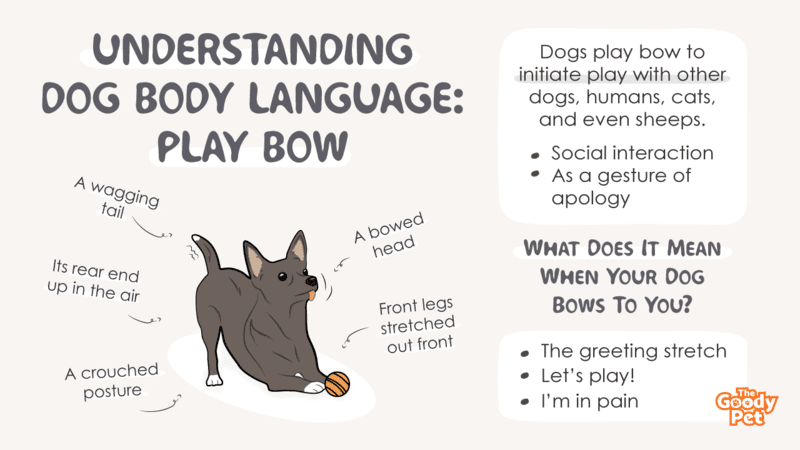Dogs not only bark, whine, and growl to communicate but also use a lot of body language to show their emotions, intentions, and desires. One of the important aspects of being a responsible dog owner is to learn to interpret what your furry pet is trying to tell you by looking at its postures, facial expressions, and gestures.
Play bow is one common gesture and dogs do this to initiate play with other dogs, humans, cats, and even sheeps. This gesture is characterized by a crouched posture, a bowed head, its front legs stretched out front, its rear end up in the air, and a wagging tail.
All dogs use this gesture, even their distant cousins like the wolves, coyotes, and African wild dogs, to signal that they mean no harm and only want to play.
Through the expression of a dog’s eye, tail position, or the way it moves, you can tell how your pet is feeling and this can lead to a better understanding and deeper bond between the 2 of you. Let’s talk more about play bow…
Why Do Dogs Bow When They Want To Play?
Dogs use a play bow to urge other dogs and animals to some fun and games. The forward movement of their front legs with the elbows down means that they are excited. And, the crouched position with their chest close to the ground indicates that they are friendly, submissive and choosing not to be dominant.
Apart from initiating social interaction, dogs bow when they want to apologize to their playmates. It is also good to know why the act of play bow is important to the well-being of your dog.
Social Interaction
The play bow is an important social interaction between dogs. When your pooch sees a potential playmate, it may initiate play by giving a friendly bark to the other dog.
Quick eye contact and sniff usually follow, and the initiator will immediately give the first play bow to show friendliness. If the other dog is receptive, they will engage in some form of play, such as chasing and playful biting or nipping.
The play bow is used not only to initiate play but also to show that they are having fun and wish to continue playing. Other times, when one dog gets tired of playing, the other will bow to show that it wants to resume the play.
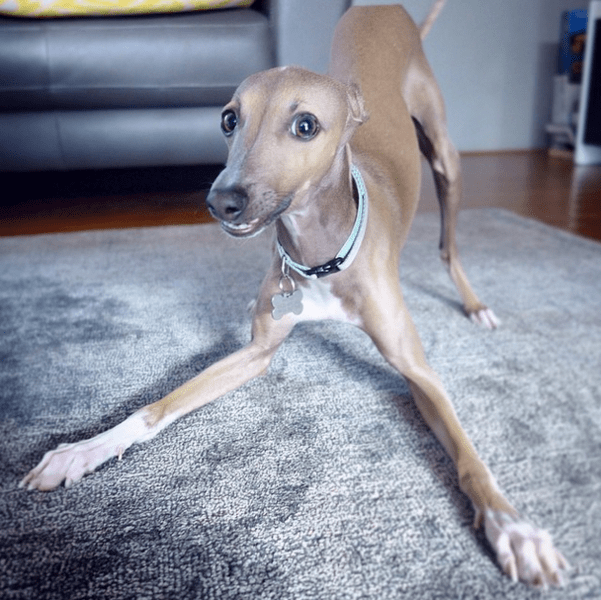
As A Gesture Of Apology
When a dog bows its head, it can be viewed as a gesture of apology when the playing gets too rough. It is their means of saying “I’m sorry and can we stop playing please?”
A lot of dog behaviorists think that play bow is a way to show that any actions they take after the bow is friendly and non-aggressive.
The Importance Of Play
Dog behaviorists think that “play” forms a key part in the dog’s social, cognitive, and physical development. They learn important behaviors like how to react quickly to new situations and learn to judge the actions of other dogs.
Playtime is also considered an evolutionary trait they learn from their ancestors as a necessary preparation for hunting later in their adulthood. A lot of the behaviors exhibited during playtime such as biting, chasing, and pouncing are similar to actions done during hunting and preying.
Playing is also an opportunity for dogs to relate with their own kind and learn valuable behaviors like moderating the strength of their bites.
What Does It Mean When Your Dog Bows To You?
You may observe that sometimes your pooch suddenly stretches in front of you and then bows its head as you are approaching it. The meaning behind this gesture could be any of the following; as a way to greet you, an invitation for play, and also a way to convey to you that it is in pain.
Greeting Stretch
When you see your pet dog leaning backward and stretching its legs in a frontal manner, it is most likely trying to greet you. This is a posture they use to someone they are comfortable with, and it is a gesture meaning, “Hello, I’m happy to see you!”
You may mistake it for a muscle stretch at times when they just woke up from sleep or a short nap. But on a number of occasions, it is often a form of greeting. So next time you see your pooch stretching and bowing to you, reciprocate the greeting with a simple pat on the back.
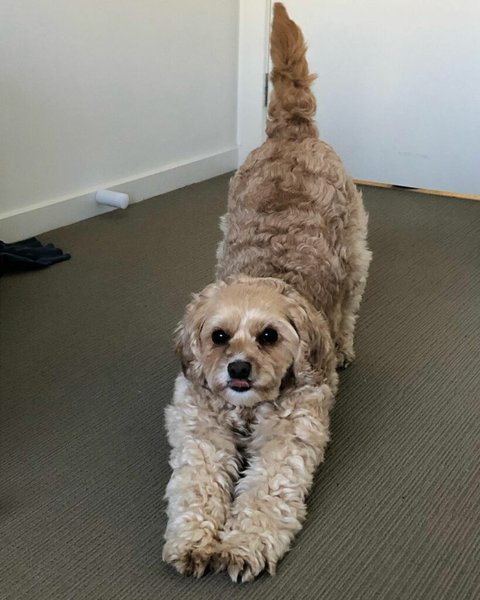
Let’s Play!
Your pooch not only sees you as its master but also its playmate. If you see your pooch suddenly crouching with a look of anticipation, especially when it is holding a toy in its mouth, you know that that is an invitation to play.
Bowing can also be accompanied by a bark, a little rumbling, and a wagging tail. These are all signals that your pooch wants some fun and games, and you should see them as signs that your dog adores you and feels safe with you.
Giving your beloved pooch some time to play with you, even for just a short time, would contribute to its overall, positive well-being.
I’m In Pain
Also, when you observe your pet lowering its head to the ground without the usual play bow stance, it may mean that he is in pain or has gotten an injury. This will be more likely if it is a sudden change in its behavior and the best course of action is to take it to the veterinarian.
Why Does My Dog Bow And Bark?
A dog bow can mean a lot of things and as a dog owner, you should be able to differentiate the emotions that your pooch might be telling you.
In this section, we will look at why a dog will bow and bark at its human family. Bowing and barking are signs that your pooch is asking for an apology, meta-communication, and as a sign of submission.
Am I In Trouble?
If you observe your pet lowering its head and tail without its front legs outstretched, and avoiding eye contact with you, it means that your pet thinks it has annoyed you and is expecting to be reprimanded. Lowering its head is your dog’s way of asking for forgiveness from you.
If this is the case, then you should consider whether some of your actions are intimidating your dog, like shouting or wiggling your fingers. Try changing your behavior and be calmer to your dog by giving it treats as a positive reinforcement.
On the other hand, a fear-based approach in training your dog, such as shouting and using excessive force, will typically jeopardize the physical and mental well-being of your dog.
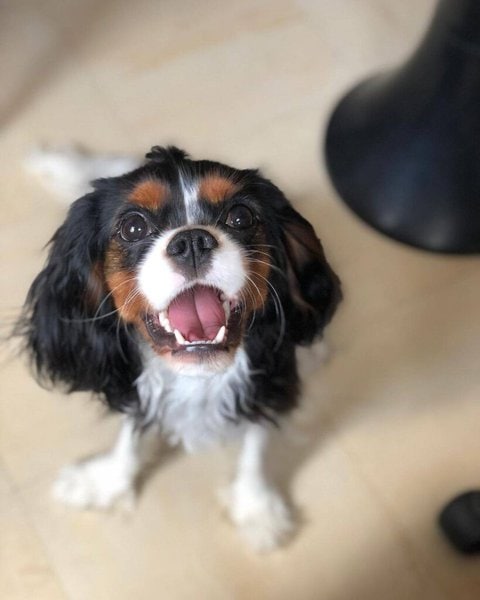
Meta-Communication
Dogs usually employ bow and barking during a pause in their play and use exaggerated and bouncy movements to signal to their human families that they are still eager for some more romping around.
Anthropologist Gregory Bateson calls meta-communication the use of body language and vocalization to signal the other dog of its intent. Dogs are shown to gesture a play bow just before or immediately after doing an assertive or aggressive behavior, like a bite, to remind its owner that it is only playing and not to be misinterpreted as an aggression.
Meta-communication allows dogs to feign actual fighting. Feigning actually allows our pooches to negotiate relationships and develop lasting friendships.
An Act Of Submission
When your dog lowers its head and tail along with slinking its body smaller to you (as well as to other dogs), it is a gesture of submission. This is your dog’s way of accepting and respecting your Alpha status in the pack.
How Do You Respond To A Dog Bow?
One way of communicating with your dogs is to take a bow to your pooch and prolong the playing time. By responding to them in a body language that they can understand, even though It may look silly, you inevitably develop a deeper bond with your dog.
Take A Bow
Although the play bow is a communication among dogs, we humans can get down on our knees and do it too.
Try imitating this action by putting both elbows on the ground and leaving your butt hanging in the air. Dogs usually respond to your action with a bouncy and springy fashion, so you can do the same by mimicking if you want your play bow to be well-received by your pooch.
You can also do this standing up by leaning over from the hips, bending both legs and spreading your arms out at a wide angle. It is best done in a springy fashion to appear more playful to the dog receiving the signal. Once your pooch gets the message, you can start running around or play chase with your dog.
A lot of dogs would find this amusing and they love it if you know how to speak their language. They are already attuned to this evolutionary behavior and seeing this behavior on their masters will create an even more special bond.
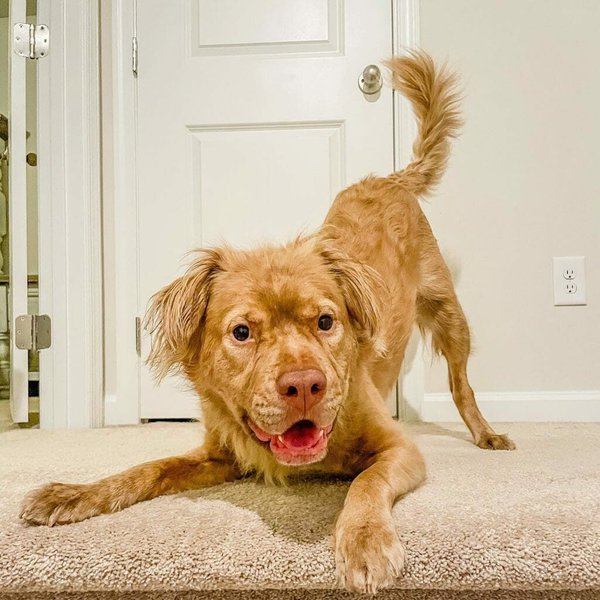
Just Play
Of course, when you see your dog do the play bow stance with you, the only right thing to do is just play with him. There are several fun things you can do with your pooch.
Frisbee
Playing frisbee with your dog connects with their normal instinct to chase. Going after a frisbee thrown over long distances also promotes physical agility and endurance.
Chase The Prey
This is another game that plays into their prey instincts. Slowly dragging a flirt pole with a toy tied at the end with a rope entices your dog to chase and this helps them to focus. This is also great to practice their impulse control by commanding “let go”.
Agility Exercise
Setting up an obstacle course is a great way to teach your dog new tricks and a fun activity to increase their mental stimulation. You can set up boxes to jump over, cones to weave through, or hula hoops to leap into. These develop its flexibility, attentiveness, and confidence.
Can A Play Bow Be Aggressive?
The best way to determine if a play bow is not aggressive, or your dog is just playing, is when it plays bow. It has been shown that a play bow comes before, during, and after play to signify that the playful bites and ear pulls to come are meant in the spirit of fun and games known and self-handicapping.
How To Tell If They Are Being Aggressive?
Dogs communicate through play. They have evolved a set of signals to reduce the likelihood that play fighting will result in escalation.
Crouched posture with head to the ground and hind end in the air is known as the play bow. It is a specific signal that says I wanna play with you, not fight you or eat you or dominate you.
If you notice your dog barking at a lower range than normal while growling, snarling, and snapping with their ears erect, then this is a sign that they are being aggressive. As an additional indicator, their posture may be still and rigid. Normally, a relaxed body signifies a relaxed dog.
This does not mean that your dog may be unstable, but it may be expressing its frustration by being aggressive. Dog aggression can be grouped in various factors such as fear, possessiveness, defensiveness, pain, possessiveness, or social competition.
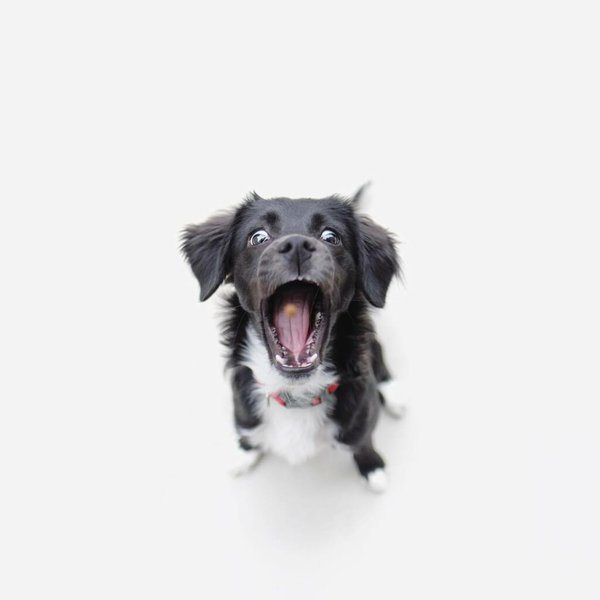
Self-Handicapping
Since dog play includes many of the behaviors observed during real fights like neck biting or forcing another partner to the ground, one might think that it is real dog fight. But some differences occur between playing and fighting.
When dogs are just being playful, they withhold the force of their bites and sometimes voluntarily give their playmates a competitive edge which is called self-handicapping.
This act allows the weaker dog to match the abilities of their stronger play partner. The stronger dog may also roll on their backs and let themselves get caught during a chase to show cooperation and build better relationships with other dogs.
Here are the 4 basic rules that dogs understand:
- Ask first. Barking calls the attention of a potential play partner and only when they’re looking that the lay bow takes place. Play can then commence.
- Mind your manners. Don’t bite too hard or slam another dog too hard. They use a method called self-handicapping showing self-restraint to ensure they don’t inflict pain or injury. When things get too far, play comes to a grinding halt.
- If the dog inflicts pain, it should back off, do play bow and let the other dog decide if it is ok to play. “Okay, I trust you.” And once acknowledged, play can resume.
- Be honest. Don’t ask the other dog to play and then break the rules. Important to be fair because if an individual is a cheater, it could be ostracized in play groups.

